Best Overall for
5-String Bass
-
Overall: 9/10
-
Best Feature: Consistent intonation
-
TedScore™: 9/10
Best Value
Strings for
5-String Bass
-
Overall: 8.5/10
-
Best Feature: Consistent intonation and even tension
-
TedScore™: 8.5/10
Best Durable Strings
for
5-String Bass
-
Overall: 9/10
-
Best Feature: Excellent sustain and balanced tension
-
TedScore™: 9/10
The right set of bass strings can completely transform how your instrument sounds and feels, whether you’re playing live or in the studio.
But with so many different options, it can be tough to know where to start; what is the best bass strings for 5 string instruments?
Are you ready to unleash the true power of your 5-string bass?
First, you’ll want to choose a set of strings specifically designed for your instrument.
These strings are typically thicker and longer than standard bass strings, with an extra low B string that allows you to play even lower notes. But beyond that, there are plenty of different options to consider.
So, grab your bass, and let’s find the best bass strings for 5-string instruments!
5-String Bass Guitars and Their Unique Characteristics
If you’re a bass player looking to expand your tonal range and deliver deeper grooves, it’s time to consider a 5-string bass guitar.
These instruments have an extra low B-string that adds a whole new dimension to your playing. But what makes 5-string bass guitars so special? Let’s find out!
Extended Range
The most obvious characteristic of a 5-string bass guitar is its extended range. With the addition of a low B-string, you can reach lower notes than on a standard 4-string bass.
This allows you to enhance your basslines with deep, rumbling tones and give your music a fuller sound.
Increased Versatility
The extra string expands your playing options, allowing you to explore multiple genres and styles.
The added string opens up a world of possibilities, whether you’re into funk, metal, jazz, or any other genre.
You can effortlessly switch between low-end power and higher melodic lines, giving you more versatility on stage or in the studio.
Enhanced Harmonic Options
With the low B-string, you can create richer and more complex harmonies.
You can experiment with chord inversions, play double stops, and create unique voicings that were previously unattainable on a 4-string bass.
This opens up opportunities for creativity and adds depth to your bass lines.
Extended Fretboard
To accommodate the additional string, 5-string bass guitars have a wider neck and an extended fretboard.
While this may feel different at first, it allows for comfortable playing and better access to higher notes. Whether you prefer playing fingerstyle or with a pick, you’ll appreciate the extra room on the fretboard.
Improved Soloing and Melody Lines
The low B-string is not just for rumbling basslines; it also enhances your soloing abilities. You can effortlessly incorporate lower notes into your solos, making them more dynamic and interesting.
The added range lets you perform melodic lines that were previously out of reach, allowing you to stand out during instrumental sections.
Importance of Choosing the Right Bass Strings for Playing a 5-String Bass
When playing a 5-string bass, choosing the right strings is crucial for achieving the best sound and playability. The strings you choose can make or break your playing experience.
Here are some reasons why choosing the right bass strings is important:
Tone
Playability
Durability
Compatibility
Characteristics of 5-String Bass Strings
Let’s explore the unique qualities of 5-string bass strings and how they differ from traditional 4-string bass strings.
String Gauge and Material
The string gauge and material are two of the most important characteristics when selecting 5-string bass strings.
The gauge refers to the thickness of the string, and the material refers to the metal used to make the string.
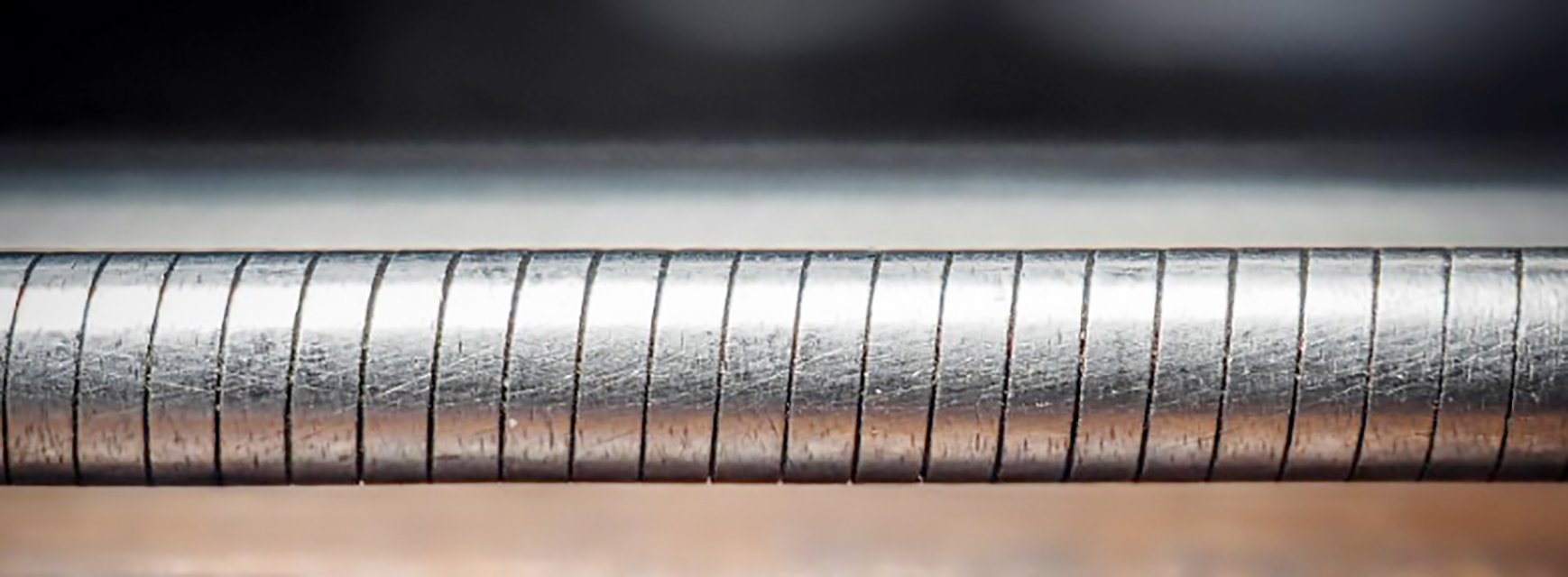
For 5-string basses, the most common string gauges are .045 to .130. The gauge you choose will depend on your playing style and the sound you’re looking for.
Some players prefer thicker strings for a heavier sound, while others prefer thinner strings for easier playability.
As for materials, several options are available, including stainless steel, steel, cobalt, nickel-plated steel, high-carbon steel, and nickel wound.
Each material has its unique sound and feel, so it’s important to experiment with different materials to find the one that suits your playing style.
String Tension and Balance
String tension and balance are also important factors when selecting strings for your 5-string bass.
The string’s tension refers to how tight or loose it feels when playing, and the balance refers to how evenly the tension is distributed across all strings.
The strings’ tension and balance can affect the bass’s intonation and playability, so choosing well-balanced strings with consistent tension across all strings is important.
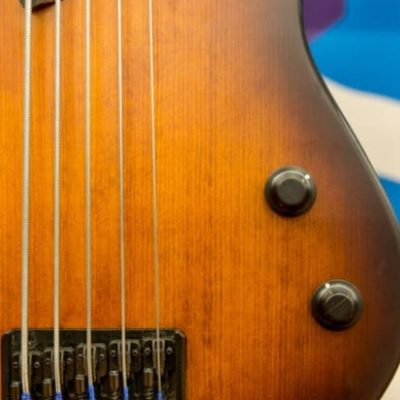
Recommended Gauges for 5-String Bass Playing

While the gauge you choose ultimately depends on your playing style, some recommended gauges for 5-string bass playing are recommended.
For a standard tuning of B-E-A-D-G, a common gauge set is .045, .065, .080, .100, .130. However, some players may prefer slightly thicker or thinner strings, depending on their preferences.
Popular String Materials for 5-String
There are several popular string materials for 5-string bass, each with its own unique sound and feel.
Ultimately, the best material for you will depend on your playing style and the sound you’re looking for.
Stainless steel strings are characterized by their clear and dynamic tone
whereas nickel-wound strings produce a smoother and more rounded sound.
Cobalt strings are known for their clarity and sustain, and high-carbon steel strings offer a balanced tone with plenty of punch.
Factors to Consider When Choosing Strings for a 5-String Bass
When it comes to choosing the best bass strings for your 5-string bass, there are a few factors to consider. Here are some things to keep in mind:
Budget
Playability
Longevity
Recording
Versatility
Different Brands
Coating
Sweat and Corrosion
Top 5 Strings for 5-Strings Basses
D'Addario EXL170-5 Nickel Wound Bass Strings
D’Addario EXL170-5 Nickel Wound Bass Strings are well-suited for 5-string bass guitars due to their exceptional quality and construction.
The nickel-plated steel windings provide a balanced and versatile tone, while the strings’ consistent intonation and even tension ensure reliable performance.
Best for LOWS AND CLEAR HIGH tone
D'Addario EXL170-5 5 String Bass Guitar Strings, Light 45-130, Long
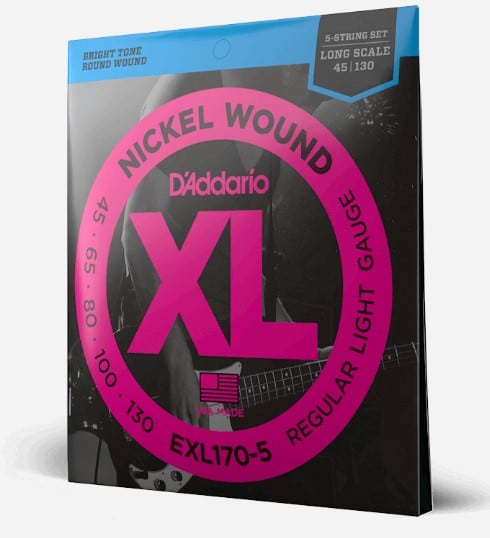
FEATURES:
- Bright, tight bass sound delivered by nickel-plated steel wrap wire
- Perfect intonation, consistent feel, and unmatched durability provided by hex-core
- Consistent intonation
- Excellent sound quality
- Long-lasting and durable
- Comfortable playability
- Nickel-plated strings may not suit players who prefer a brighter or more aggressive tone
- May not be widely available in some regions
When you click ‘Check Price’, you’ll see there are loads of great places to buy this item. Our personal favorite is Sweetwater for the US, and Thomann and Gear4Music for the UK & Europe.
They are the largest music retailers, with excellent customer service, competitive prices, really fast shipping, and the longest guarantees.
The professional musician who wrote this article combined many things,
from the product build, manufacturer’s reputation through to feedback
from other users, to create our famous TedScore™.
Ernie Ball 2836 Regular Slinky 5-String Bass Strings
The nickel-plated steel wrapping of these electric bass guitar strings produces a bright and vibrant tone while maintaining a solid low-end presence.
These strings also have consistent intonation and comfortable playability and are widely available, making them a reliable choice for 5-string bass players.
Best for Balance tone
Ernie Ball Regular Slinky 2836 Nickel Bass 5 String, 45-130
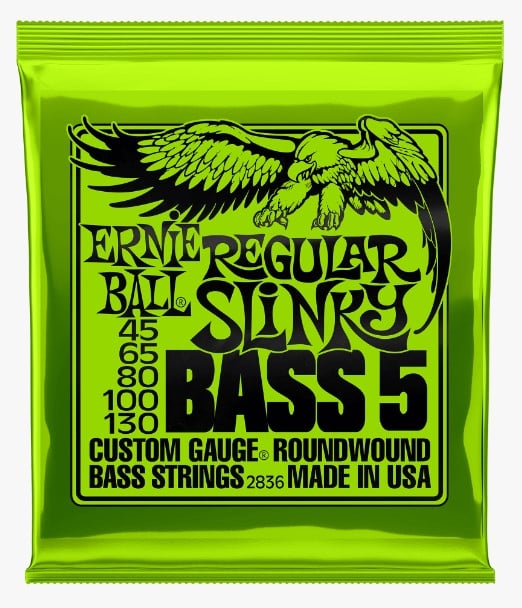
FEATURES:
- Nickel-plated steel construction
- Balanced tone with clear lows and bright highs
- Consistent intonation and even tension
- Comfortable playability and smooth surface
OTHER INFO: Text
- Versatile sound suitable for various musical styles
- Durable construction for long-lasting performance
- Widely available and easy to find
- Affordable price point
- May require frequent restringing for heavy use
- Some users may prefer a different tone for specific genres
When you click ‘Check Price’, you’ll see there are loads of great places to buy this item. Our personal favorite is Sweetwater for the US, and Thomann and Gear4Music for the UK & Europe.
They are the largest music retailers, with excellent customer service, competitive prices, really fast shipping, and the longest guarantees.
The professional musician who wrote this article combined many things,
from the product build, manufacturer’s reputation through to feedback
from other users, to create our famous TedScore™.
DR Strings PHR-5 Pure Blues Nickel Plated Bass Strings
DR Strings PHR-5 Pure Blues Nickel Plated Bass Strings are well-suited for 5-string bass guitars due to their exceptional quality and unique tone.
These strings are favored by bass players looking for a vintage-inspired tone and a versatile playing experience.
Best for smooth tone
DR Strings PB5-45 PURE BLUES Quantum 5-String Bass Strings, 45-125

FEATURES:
- Nickel-plated steel windings
- Warm and balanced tone
- Smooth feel and comfortable playability
- Long-lasting durability
- Versatile tone suitable for various genres
- Comfortable playability
- Enhanced warmth and balance in tone
- May not provide the brightest tone for certain styles
- Limited availability in some locations
When you click ‘Check Price’, you’ll see there are loads of great places to buy this item. Our personal favorite is Sweetwater for the US, and Thomann and Gear4Music for the UK & Europe.
They are the largest music retailers, with excellent customer service, competitive prices, really fast shipping, and the longest guarantees.
The professional musician who wrote this article combined many things,
from the product build, manufacturer’s reputation through to feedback
from other users, to create our famous TedScore™.
Rotosound RS665LD Swing Bass 66 Stainless Steel Bass Strings
Because of their outstanding quality and construction, these strings are an excellent choice for 5-string bass guitars.
These strings provide a balanced tension and comfortable playability and are favored by bass players across various genres for their versatile tone and durability.
Best for hard tone
Rotosound Swing Bass 66 Stainless steel 5-String Bass Guitar Strings, 40-125
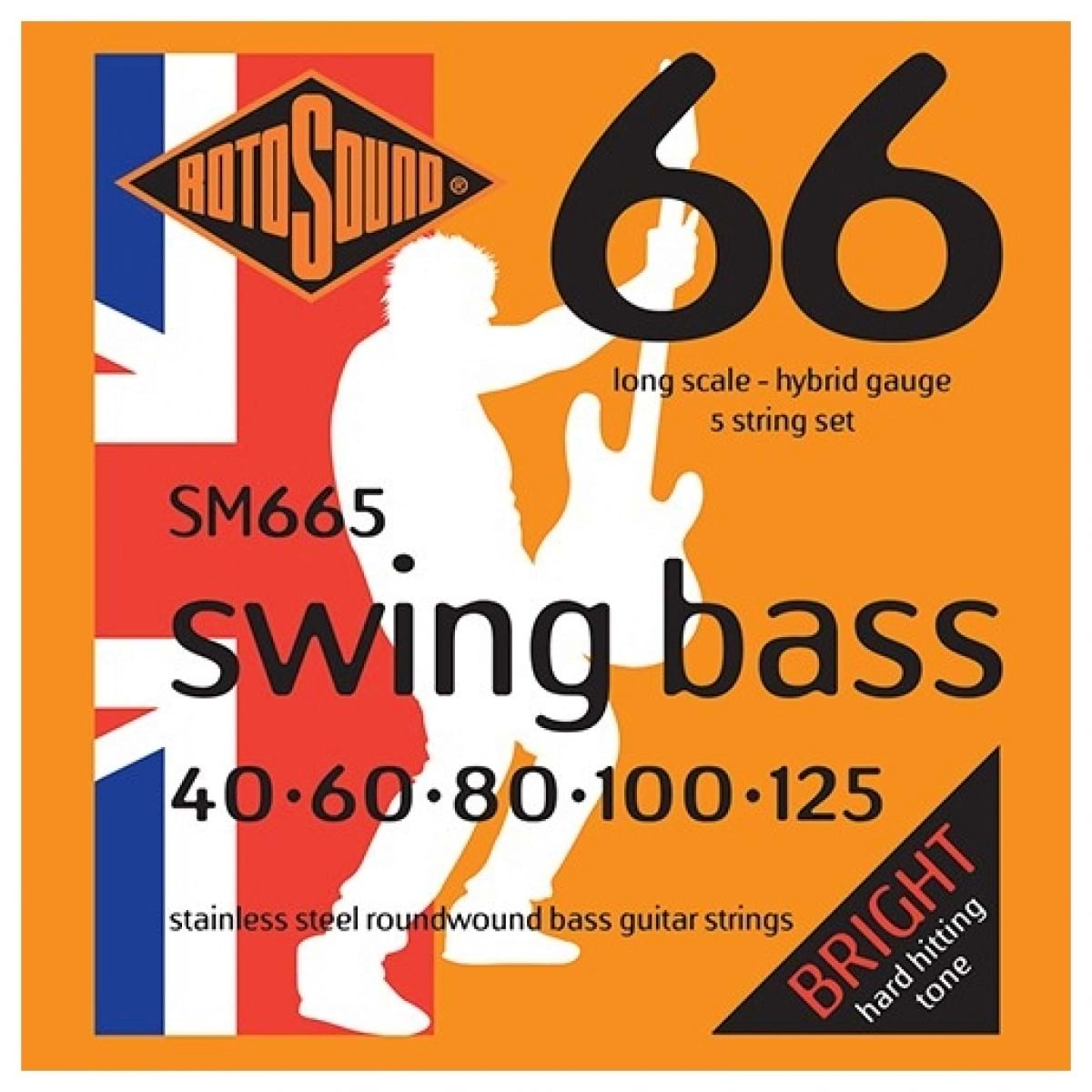
FEATURES:
- With stainless steel wrap construction
- Bright and punchy tone
- Excellent sustain and balanced tension
- Versatile sound suitable for a wide range of musical styles
- Durable construction ensures longevity
- Great for achieving a bright and punchy tone
- Balanced tension for comfortable playability
- May not be ideal for players seeking a warmer or mellower tone
- May have a higher initial price compared to some other string brands
When you click ‘Check Price’, you’ll see there are loads of great places to buy this item. Our personal favorite is Sweetwater for the US, and Thomann and Gear4Music for the UK & Europe.
They are the largest music retailers, with excellent customer service, competitive prices, really fast shipping, and the longest guarantees.
The professional musician who wrote this article combined many things,
from the product build, manufacturer’s reputation through to feedback
from other users, to create our famous TedScore™.
Dunlop Bass Superbright Nickel Light 5 String Set
The Dunlop Bass Superbright Nickel Light 5 String Set is ideal for mid-high tones due to its premium construction. Crafted from high-quality nickel, these strings produce a clear, bright sound with exceptional sustain, making them perfect for cutting through the mix and delivering articulate mid-high frequencies.
Whether you’re playing slap bass, funk, or any genre that requires a punchy and defined mid-high tone, these strings are designed to meet the demands of discerning bass players.
Best for mid-high tone
Dunlop Bass Superbright Nickel Light 5 String Set
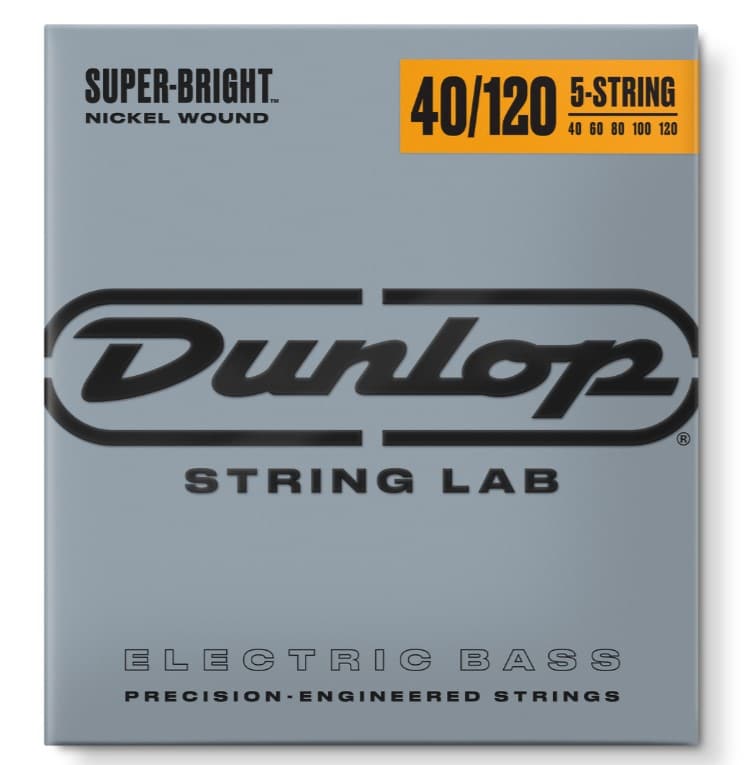
FEATURES:
- High-quality nickel-plated steel construction
- Super bright and articulate sound
- Enhanced low-end response
- Long-lasting strings with great durability
- Versatile for various music genres and playing styles
- May be too bright for players seeking warmer tones
- Initial stiffness requires some time to break-in
When you click ‘Check Price’, you’ll see there are loads of great places to buy this item. Our personal favorite is Sweetwater for the US, and Thomann and Gear4Music for the UK & Europe.
They are the largest music retailers, with excellent customer service, competitive prices, really fast shipping, and the longest guarantees.
The professional musician who wrote this article combined many things,
from the product build, manufacturer’s reputation through to feedback
from other users, to create our famous TedScore™.
Tips for Playing a 5-String Bass
If you’re new to playing a 5-string bass, navigating the wider neck and fingerboard can be intimidating.
However, with a few techniques and tips, you can take advantage of the extended low range and incorporate the low B string into your playing.
Techniques for Navigating the Wider Neck and Fingerboard
Playing a 5-string bass requires some adjustments to your technique. The wider neck and fingerboard can be challenging, but you can navigate it easily with practice.
Here are some techniques to help you get started:
While Playing On The Lower Strings.
To Get Comfortable With The Wider Fingerboard.
To Find What Feels Most Comfortable For You.
Tips for Incorporating the Low B String into Your Playing
The low B string is one of the biggest advantages of playing a 5-string bass. It allows you to play notes unavailable on a 4-string bass in standard tuning.
Here are some tips for incorporating the low B string into your playing:
To Add Depth And Power To Your Basslines.
On The Low B String.
To Find What Works Best For You.
Common Playing Styles and Techniques Used by 5-String Bassists
5-string bassists often use a variety of playing styles and techniques to take advantage of the extended low range.
Here are some common styles and techniques used by 5-string bassists:
Slap bass
Harmonics
Modern styles
By incorporating these techniques and tips into your playing, you’ll be able to take full advantage of the extended low range of a 5-string bass and create powerful, dynamic basslines.
Tips for Adjusting String Tension and Action on a 5-String Bass
Adjusting the string tension and action on your 5-string bass is crucial to ensure that it plays and sounds the way you want it to. Here are a few tips to help you get started:
String Tension
String tension refers to the pressure the strings exert on the neck of the bass. If the tension is too high, it can make the bass difficult to play, while low tension can result in a lack of sustain and a muddy tone.
To adjust the string tension on your 5-string bass, you can try the following:
Experiment with different string gauges
Adjust the truss rod
Use a multi-scale bass
Action
Your bass’s action refers to the strings’ height above the fretboard. High action can make the bass harder to play, while low action can result in fret buzz and other issues.
To adjust the action on your 5-string bass, you can try the following:
Use a straight edge
Adjust the bridge saddles
Check the nut slots
Intonation
Intonation refers to the accuracy of the notes played on the bass. If the intonation is off, the notes may sound out of tune, even if played correctly.
To adjust the intonation on your 5-string bass, you can try the following:
Use an electronic tuner
Adjust the saddle position on the bridge
Check the nut slots
By following these tips, you can adjust the string tension and action on your 5-string bass to achieve your desired sound and playability.
Best Bass Strings For 5 String
A Recap
When finding the best bass guitar strings for a 5-string bass, there are a few key factors to consider.
Firstly, it’s important to consider the type of music you play and the tone you want to achieve. Different bass string materials, such as nickel or stainless steel, can greatly impact the sound and feel of the bass.
Also, considering the gauge of the strings is crucial, as some prefer heavier gauges for their robust tone and increased durability.
Lastly, finding strings that strike the right balance between playability and longevity is essential, as you want strings that feel great under your fingers and last a decent amount of time.
Ultimately, experimentation and personal preference play a significant role in finding the best bass strings for your 5-string bass.
So, don’t be afraid to try different brands and types until you find the perfect match for your playing style and musical preferences. Best of luck!
Wait, there’s more!
Looking for the perfect complement to your 5-string bass? Elevate your sound with our 14 Best Bass Amps, guaranteed to take your playing to the next level!
FAQ's
There’s no one-size-fits-all answer, as the best strings for a 5-string bass will depend on your playing style and genre preferences.
However, some top options include D’Addario NYXL, Rotosound Swing Bass 66, and La Bella Deep Talkin’ Bass
The string gauge for a 5-string bass will depend on your playing style and genre preferences.
However, a common gauge for the low B string is .130-.135, while the gauge for the high G string is typically .040-.045.
Most bass players use roundwound nickel-plated steel strings, providing a bright, versatile tone that works well for various genres and playing styles.
However, the type of strings used can vary depending on individual preferences and playing styles.
A 5-string bass can be tuned to various tunings, but the most common is B-E-A-D-G, with the low B string providing extended range for lower notes.



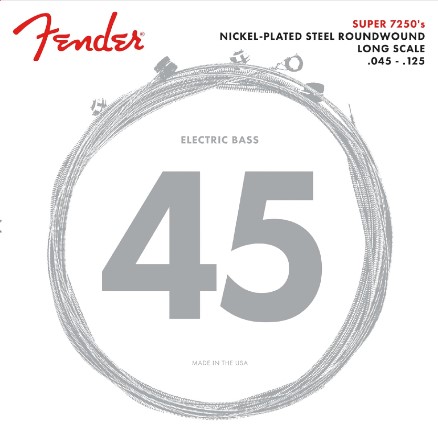







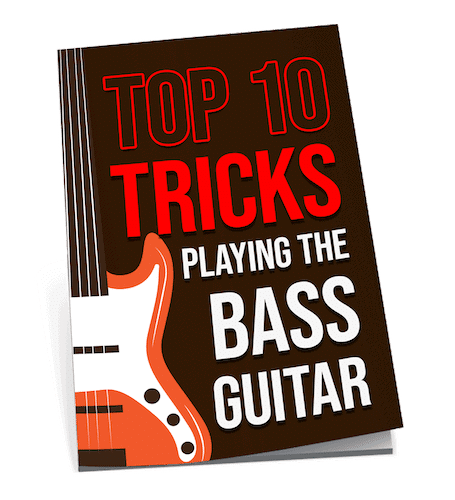
Lows and clear high tones, huh? Guess that’s fancy talk for ‘it sounds good’. But seriously, props for breaking down the fancy jargon into something even my grandma could understand. Good job, Hugh Richardson.
I found the section on the importance of choosing the right bass strings particularly insightful. It’s a topic that’s often overlooked but crucial for achieving the desired sound and playability. Especially, the point about compatibility hit home for me as I’ve struggled in the past to find strings that match my playing style and the genres I explore. The comprehensive breakdown of string types and materials was also much appreciated, providing a deeper understanding of how each aspect influences the overall playing experience. Kudos to Hugh Richardson for compiling such a well-thought-out guide.
man, those DR Strings Pure Blues, they hit different. been playing bass for over a decade and once you go DR, there’s no turning back. Also, that bit about string tension’s spot on. Mismatched tension feels like driving a car with one flat tire. Balance is key.
Totally agree on the DR strings, but don’t you think materials play a bigger part in sound than tension? Just curious on your take.
Hey Hugh Richardson, I’m new to this whole 5-string bass world and was curious about how the extended range affects playing styles? Does it mean I gotta learn a bunch of new techniques, or can I just dive in with what I know from my 4-string experience?